
Fractions, Decimals and Percentages | Cambridge IGCSE Mathematics
[Please watch the video attached at the end of this blog for a visual explanation of fractions, decimals, and percentages]
While appearing to be a very small part of a lesson, fractions, decimals, and percentages will play a role in almost every other major topic that you will get. There’s nothing to worry about though, as this lesson is pretty easy! In this blog post, we will be going through how to convert the three of them to one another and the basic steps of adding, subtracting, multiplying, and dividing fractions, decimals, and percentages.
Fractions
Addition Of Fractions
The important thing to remember about adding and subtracting fractions is that there has to be a common denominator.
If you look at the example given below, you will note that ⅗ and ⅞ cannot be added together, as they do not have the same denominator. In order for them to have a common denominator, we have to multiply the first fraction ⅗ by 8 (note that both the numerator and denominator must be multiplied by the said number) and then multiply the second fraction ⅞ by 5 (note once again that both the numerator and denominator need to be multiplied with the said number).
This gives us our common denominator 40, and now the new fractions would be 24⁄40 and 35⁄40.
We can easily add the two fractions together now. However, remember that when adding, the denominator stays the same and it is only the numerators that need to be added.
Accordingly, as 24+35 is 59, the answer in fraction form would be 59⁄40. This is an improper fraction, so you can turn it into a mixed fraction as the final answer.
There’s a 40 in 59, therefore it can be considered as a whole 1. Once you subtract 40 from 59 (59 - 40), the answer you get is 19. Hence in mixed fraction form, the answer will be 1 19⁄40.
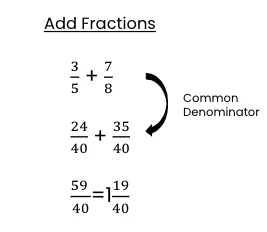
Subtracting Fractions
This is quite similar to the addition process because we need a common denominator here too. Once you multiply both fractions by certain numbers to get the common denominator.
However, if you look at the example given below, you can see that there is a mixed fraction (a whole number and a fraction), so before anything else, you must first turn this into a mixed fraction. Then, like in the previous example, you can subtract one number from the other (remember, the denominator does not change) and you can easily find out the answer.
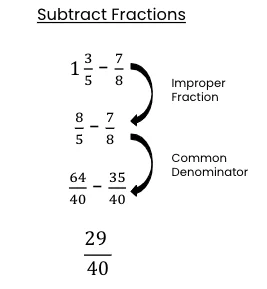
Multiplying Fractions
This is a bit different from both adding and subtracting fractions.
When multiplying fractions, you simply multiply the numerators together and then the denominators together. There are two ways to do it easily.
- Simplifying before multiplying
- Simplifying after multiplying
Whichever method you choose, the answer, in the end, will be the same!
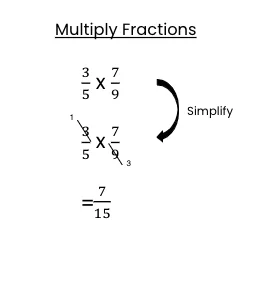
Dividing Fractions
When dividing fractions, we must first see if there are any mixed fractions. If there are any, they must first be converted into an improper fraction. The next step is to keep the first fraction as it is, and then flip the second fraction so that the second fraction becomes a reciprocal of what it was initially (for example, if the second fraction is 15⁄4 after converting it into an improper fraction, once you flip it, this becomes 4⁄15. When you flip the second fraction, replace the division symbol with a multiplication symbol. Now, you can very easily multiply the fractions together and reach the answer you want.
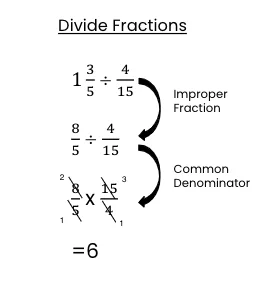
Converting Fractions to Decimals and Percentages
When fractions to decimals, we divide the numerator by the denominator.
For example, if the fraction is ⅗ and you wish to convert it into a decimal, then you can simply divide 3 by 5, and you will get the answer to be 0.6.
Similarly, if you are converting fractions to percentages, you can take the given fraction and multiply it by 100. For example, if you multiply ⅗ by 100, then you get 60% as the answer.
Decimals
Addition of Decimals
When you add decimals, you must pay close attention to where the decimal point is.
In the example given below, when adding 0.05 to 123.568, you have to align the decimal points so that they are under each other in a vertical line. This addition will therefore result in 123.618.
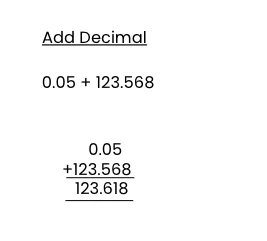
Subtraction of Decimals
Similarly, when you’re subtracting as well, it is very important to align the decimal points of the numbers vertically and accordingly. Be careful when carrying the balance as this is one instance where students tend to fall into the trap of not carrying numbers forward and tallying the previous number.
Multiplication of Decimals
When multiplying decimals, it is also equally important to keep in mind the decimal places. Ideally, when you multiply decimals, you should initially multiply the numbers as if there are no decimals. This will definitely make things easier.
If you consider the example below, if we pretend that there are no decimal points involved, a simple multiplication of just the numbers 11123 by 7 will give us the answer 77861. Once you get the answer what you must do is you have to insert the decimal point.
Before inserting the decimal point where necessary, first count how many decimal values are there in both numbers. There are three decimal values in the first number and two decimal values in the second number. This adds up to five decimal values in total, so you have to count five places from your right and then add the decimal point. The answer is 0.77861.
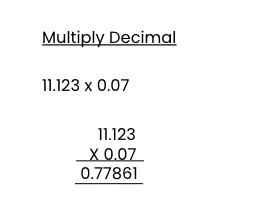
Division of Decimals
This is pretty much like dividing a normal number and getting the answer will not be a hassle. Be mindful of the decimal point though, as you need to put it directly after the whole number has been divided.
Converting Decimals to Fractions and Percentages
To convert a decimal into a fraction, you need to pay attention to the number of decimal values. If there is just one decimal value, then you put the number over 10 and then simplify it. If there are two decimal values, the number will be over 100, 3 decimal places over 100, and so on and so forth.
To convert a decimal to a percentage, just like in fractions, you multiply it by 100.
Converting Percentages to Fractions and Decimals
Percentages are values out of 100, therefore they can be written very simply as a fraction out of 100. For example, 60% can also be written as a fraction in the form of 60⁄100 and then once it is simplified, it will give an answer ⅗.
If you wish to convert a decimal into a percentage, you multiply the decimal by 100 and place the decimal point in the correct place.
Tips for practicing fractions, decimals, and percentages to prepare for your Cambridge IGCSE Mathematics exams.
Practice a variety of sample questions that feature this topic, because although quite simple, you might end up making careless mistakes, especially with decimal points. The question banks at Tutopiya have questions of different difficulty levels that you can practice before your actual exams.
Ask for help – You are never too late to ask for assistance if you’re struggling. Reach out to us at Tutopiya to find the right tutor to help you pass your exams with flying colors!
Watch the video below for a visual explanation of fractions, decimals, and percentages, as well as instructions on how to enter fractions and decimals in the calculator. Next, attempt the quiz to challenge yourself!
https://www.youtube.com/watch?v=xt6NLVBCFgI
Written by
Tutopiya Team
Educational Expert
Related Articles
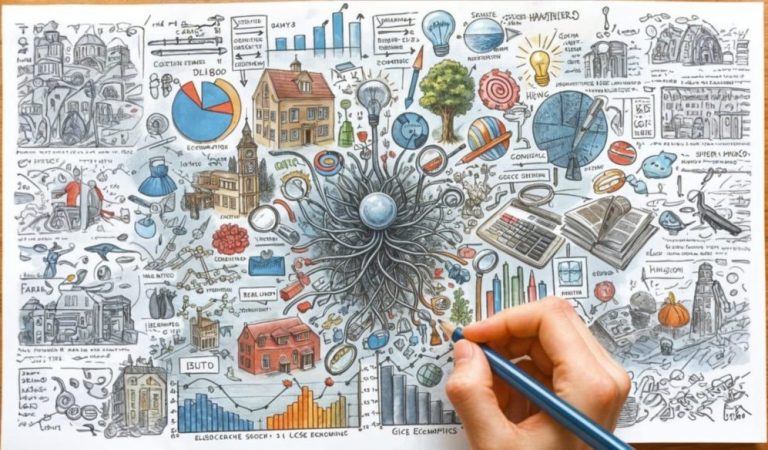
What’s Next After A-Levels? Figuring Out Your Next Step
Comprehensive guide and expert insights on educational topics for IGCSE, IB, and international curriculum students.

IGCSE Economics Revision Resources, Past Papers, and More
Master IGCSE Economics with essential revision resources & past papers. Ace your exams with global support. Ideal for IB & A-level students too.

Why Personalized Learning Beats Group Classes for IGCSE
Comprehensive guide and expert insights on educational topics for IGCSE, IB, and international curriculum students.


